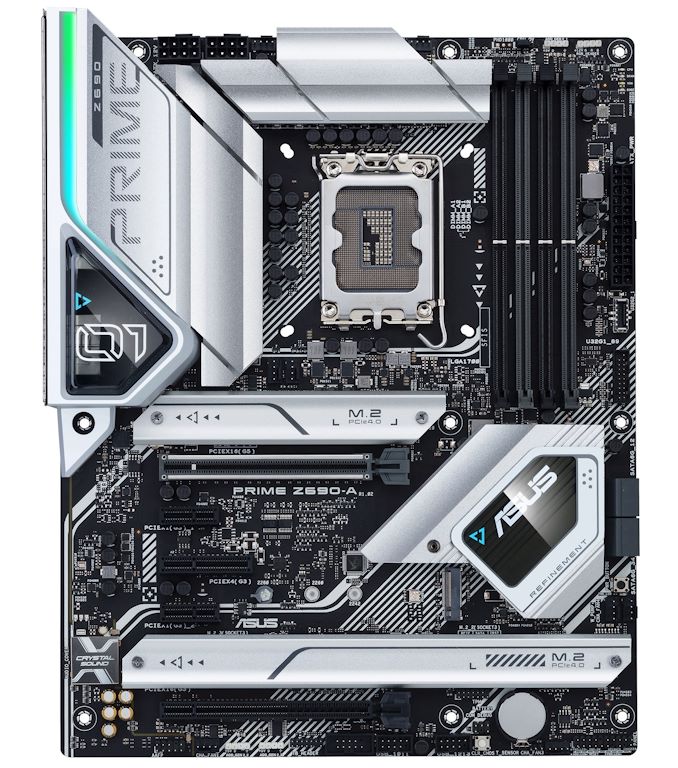The Intel Z690 Motherboard Overview (DDR5): Over 50+ New Models
by Gavin Bonshor on November 9, 2021 9:00 AM ESTASUS Prime Z690-A (DDR5)
The ASUS Prime series of motherboards is perhaps one of its most key ranges. It represents the more affordable and entry-level segment, with functional features, wallet-friendly controllers sets, but all packed into a basic, yet elegant theme. The ASUS Prime Z690-A includes a futuristic black and silver design throughout, with plenty of premium features, and as such, sits more towards the mid-range than the entry-level. It includes a fanciful rear panel cover with the Prime series logo, with a black opaque panel just below this. The same design is present on the chipset heatsink, and the PCB is primarily black with white patterning.
On the lower section of the ASUS Prime Z690-A is a varied selection of PCIe slots. At the top, ASUS includes a full-length PCIe 5.0 x16 slot, while at the bottom is a full-length PCIe 3.0 x4 slot. In between these is a half-length PCIe 3.0 x4 slot, with two smaller PCIe 3.0 x1 slots. For storage, there's a total of four M.2 slots, including three PCIe 4.0 x4 slots, one PCIe 4.0 x4/SATA slot, and four SATA ports. In the top right-hand corner is four memory slots that are capable of supporting DDR5-6000 and have a maximum capacity of 128 GB.
On the rear panel on the Prime Z690-A is one USB 3.2 G2x2 Type-C, one USB 3.2 G2 Type-C, two USB 3.2 G2 Type-A, and four USB 3.2 G1 Type-A ports. ASUS includes a pair of video outputs consisting of a DisplayPort and HDMI, with five 3.5 mm audio jacks and S/PDIF optical output powered by a Realtek S1220A HD audio codec. Last but not least, there's one Ethernet port that is driven by an Intel I225-V 2.5 GbE controller.












126 Comments
View All Comments
GeoffreyA - Saturday, November 13, 2021 - link
Certainly, there are tradeoffs, keeping a socket; but, as Mr. Tuvok would say, "Ryzen, you are an unending source of astonishment." There was a time when sockets even took CPUs from different manufacturers. I remember my Socket 7 motherboard, though I never tried it, could take a K5 and some Cyrix CPUs as well. Those 5x something, something. How things have changed.A short-lived socket can be a pain in the behind too. I was one of those unlucky folk who ended up with Socket 754 and missed out on dual-channel DDR and a long upgrade path. In any case, that computer went kaput after four years.
Oxford Guy - Wednesday, November 10, 2021 - link
Overclocking is for employees of motherboard companies.ECC RAM support should have been a standard feature from the beginning. Apple offered it on the Lisa in ‘83 and consumer computing has gone backward since.
Doublers, though... aren’t a bad thing as long as they’re implemented well — as I understand it. Better to have a good doubler implementation than a weak individual phase system. The main thing is to have a board meet the minimum spec for reliable (i.e. not overheating and/or failing) long-term support of its supported CPUs. Anything beyond that is unnecessary.
GeoffreyA - Saturday, November 13, 2021 - link
The problem with doublers is, they over-use it as a marketing technique to give the impression that a certain board has a large amount of phases.Oxford Guy - Saturday, November 13, 2021 - link
Weak phases with a mediocre/poor regulator aren’t necessarily better than ‘marketing phases’ via the use of doublers. That’s the case when the doublers are used a correctly.There are a lot of shenanigans, though — like not even utilizing the doubler fully but counting it as the doubling of phases. I also recall that one of the big tricks was putting extra chokes on the board to make it look like there are more phases.
GeoffreyA - Sunday, November 14, 2021 - link
Quite right, and one of the reasons why people have got to read a proper analysis of the VRM, or take a look at the lists on hardwareluxx for example.t.s - Tuesday, November 9, 2021 - link
Wish Intel go with their atv12vo. Or like business lines from HP, Dell, Lenovo, etc. 6 or 8 pin.shabby - Tuesday, November 9, 2021 - link
Mobo prices will go up even more, screw that.meacupla - Tuesday, November 9, 2021 - link
In the long term, I think the cost for ATX12VO will be cheaper.ATX12VO PSU will be cheaper than a comparable quality ATX PSU.
The BoM for 12V to 5V and 12V to 3.3V converters would go down, if mobo makers decide to stick to a single, standardized design.
With the way things are looking, electricity prices are unlikely to go down and continue to go up.
DigitalFreak - Tuesday, November 9, 2021 - link
All ATX12VO is doing is shifting the cost from the PSU to the motherboard.Wrs - Wednesday, November 10, 2021 - link
If mobo makers can stick to one design why can't PSU makers? They already conform to ATX.ATX 12 VO increases costs for piecemeal upgraders because of the simple observation that PSUs outlive motherboards. The question would be whether the power savings are worth it. For prebuilts they're comparing power savings to 0 net component cost so 12VO is already the norm.